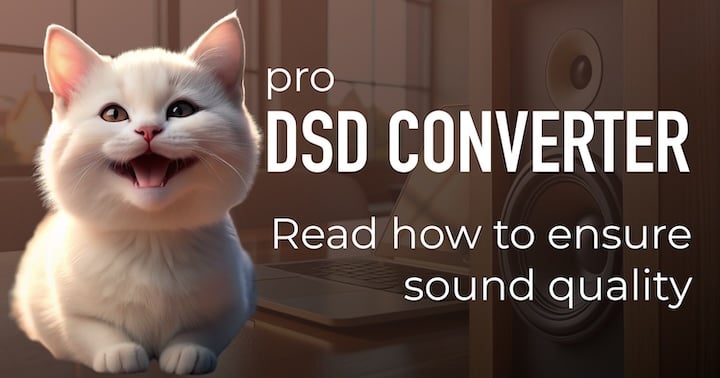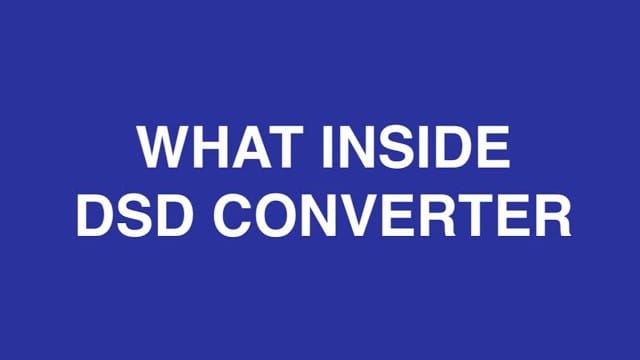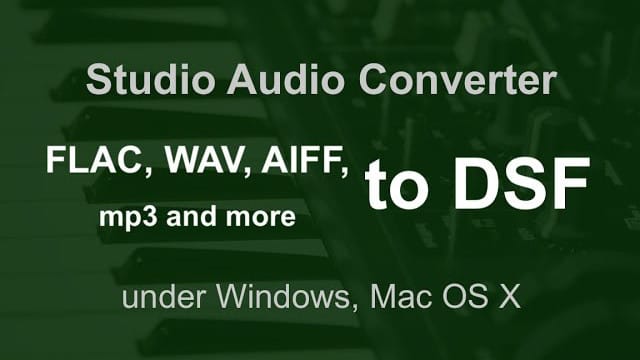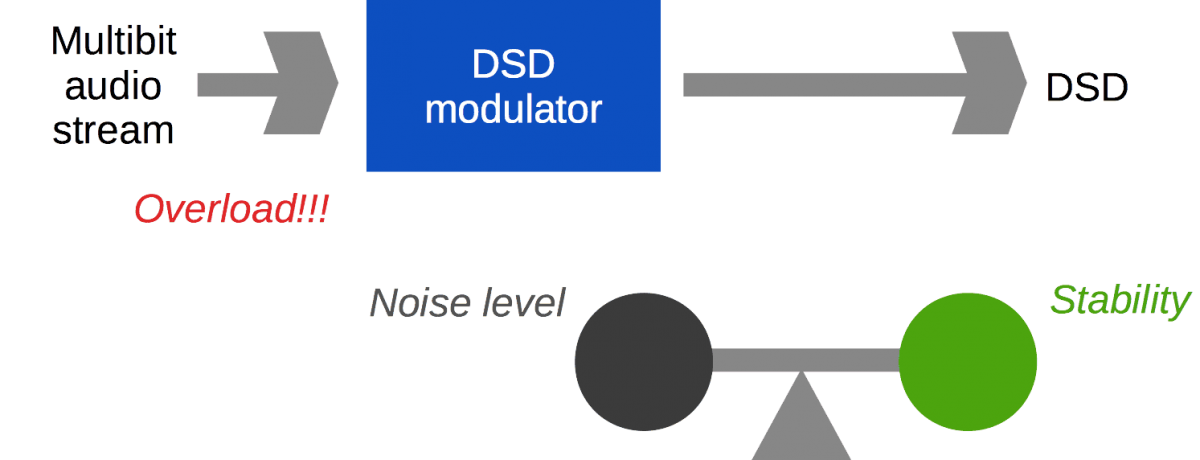
Do you love listening to music with high-quality sound? If so, you might be interested in DSD audio files. DSD stands for Direct Stream Digital, a format that delivers amazing sound quality.
But not all devices and players can play DSD files. Sometimes, you might need to convert them to other formats, like WAV or mp3. Or you might want to convert other formats to DSD files, to explore the best audio quality possible on your equipment. That’s why you need a professional DSD converter.
A DSD converter is a software that changes audio file format to match your equipment and preferences. Top sound quality of conversion is very important for this audiophile format. In this article, you will learn how a DSD converter works and how to use it to achieve the best possible result.

If you buy "AuI ConverteR PROduce-RD" (2023/12.x version) from 24 August 2023 to 24 October 2023, you will get free update to version 2024 (13.x) after its release.

How to convert DSD to/from other audio formats?
If you want to learn how to convert the format of your audio files, you can read these tutorials:
- How to convert DSD files to PCM, mp3, WAV, or FLAC files | click here >
- How to convert WAV, FLAC, mp3, or PCM files to DSD files | click here >
- How to convert SACD ISO files to DSD files | click here >
- How to convert SACD ISO files to WAV, FLAC, or PCM files | click here >
- How to convert DSD files to different DSD files | click here >
- How to convert CD files to DSD files | click here >
How to convert PCM to DSD files
You can change the format of your audio files from PCM to DSD:
- Open AuI ConverteR software
- Click on Open files button and choose the audio files you want to change. They can be .wav, .flac, AIFF, mp3, or others.
- In the main window, choose the new format for your audio files. It can be .dsf or .dff.*
- In the main window, choose the quality settings for your new audio files (sampling rate and bit depth).
- Choose where you want to save your new audio files (output file directory).
- Click on Start button and wait until the process is done.

* WARNING:
DVD-audio/video, Blu-Ray, DVD/BluRay/CD ISO are NOT supported.
For Modula-R version, SACD ISO, DSF, DFF are supported in proper configurations.
For ISO tracks, DSF, DFF longer than 3 minutes, FREE edition mutes 2-second silence in the output middle and has other restrictions. In batch conversion FREE version mutes 2 seconds in the output middle for second and the subsequent files.
Free version has processing sound quality identical commercial editions.
How to convert DSD to PCM audio files read here...
Do you want to change the format of your audio files? Do you want to enjoy high-quality sound with AuI ConverteR software? If yes, then you need to choose the right converter configuration for your needs. Here are the lowest prices for different types of conversion:
Back to top
What is DSD format
DSD is a type of digital audio format that produces high-quality sound. It is different from other formats because it uses only one bit of information for each sound sample. This means it can capture very small changes in sound.
DSD has different levels of quality depending on how fast it samples the sound. In the first approach, the faster it samples, the higher the quality. The levels of quality are measured in MHz, which stands for millions of times per second. Here are some examples:
- 2.8 MHz = 2 822 400 times per second = 44100 times x 64;
- 5.6 MHz = 5 644 800 times per second = 44100 times x 128;
- 11.2 MHz = 11 289 600 times per second = 44100 times x 256;
- 22.6 MHz = 22 579 200 times per second = 44100 times x 512;
- 45.2 MHz = 45 158 400 times per second = 44100 times x 1024;
- and so on.
The bit depth of DSD is always 1 bit.
If you want to listen to some music in DSD format, you can download free samples here: DSD 64, DSD 128, DSD 256, DSD 512, DSD 1024.
If you want to learn more about DSD format, you can read details here.
Back to top
How DSD converter works
A DSD converter is a software that changes the format of audio files. It can do two things:
1. Change PCM files to DSD files, or
2. Change DSD files to PCM files, or
3. Do both things.
4. It can also adjust the quality of the audio files (DSD resampling or changing of sample rate).

PCM files have many bits of information for each sound sample. DSD files have only one bit of information for each sound sample. To change PCM files to DSD ones, the DSD converter reduces the number of bits. This should make the sound more noisy (quantization error).
The most important part of the sound is between 0 and 20 kHz. The DSD converter moves the noise above 20 kHz. This is called "noise shaping".
To change DSD files to PCM ones, the DSD converter removes the noise. This makes the sound more clear. But sometimes, there are still some unwanted sounds (artifacts) in the final result.
Back to top
How to change PCM files to DSD files
To change PCM files to DSD files, you need a special process called sigma-delta modulation. This process is complex and sensitive. Sometimes, the process of changing the format of audio files can go wrong. This can happen if the sound is too loud or if the process tries to remove too much noise. If that happens, you need to restart the conversion. You also need something else to make it work again.

The design of sigma-delta modulation is a balance between working well and making less noise. Noise is the unwanted sound that comes from support Direct Stream Digital format. The process tries to move the noise away from the important part of the sound, which is between 0 and 20 kHz. But if it moves too much noise, it can stop working well. It can also stop working well if there is too much sound to change.
To make the sound clearer and keep the process working well, the sound outside the important part must have some extra space. This can be done by making the samples faster (more samples per second). Making the samples faster is a simple way to make more space and less noise in audible sonic range.
The author of this text does not know the exact story of how DSD was made. But it seems that DSD64 was made for sending sound up to 20 kHz. Usually, changing DSD to analog audio is easier than the other way around (read more). So changing 44 kHz/16 bit to DSD64 may have some benefits.
To send sound up to 100 kHz with less noise, the simplest way is also to make the samples faster.
If you want to learn more about sigma-delta modulation, you can click here...
.
Back to top
DSD demodulator (convert from DSD)
Sigma-delta demodulator (DSD to PCM) or DSD demodulator is a low-frequency filter, that removes modulation noise. The noise is located above the audible range.
DSD demodulator

This filter has 3 features:
- passband (minimum 0 ... 20 kHz);
- stopband (band where DSD modulator noise is suppressed);
- transient band (band between pass and stop bands).
A wider transient band allows decreased ringing audio, but pass more energy of noise of DSD modulator.
If expand passband, DSD's noise energy in the band is also increased. If the passband becomes narrower, ringing is increased.
So DSD demodulator is a balanced technical decision.
Read more about DSD decoder >
Back to top
DSD resampling
Resampling of DSD is a digital audio processing. Performed via multiple upsampling/downsampling with digital filtering.
Before resampling a file, DSD is converted without losses to a multi-bit audio stream suitable for processing. After it, the stream is processed and converted back to DSD via modulator.
Resampling 1-bit audio cause little losses, comparable with losses for PCM resampling. There are losses defined by distortions of used implementation of processing.
However, the playback apparatus may have different distortion levels for various sample rates. Hence, resampling may give benefits, if DSD is converted to a sample rate that causes minimum distortions on a used DAC.
Resampling DSD audio file
for sample rate that causes minimum distortions on a used DAC

Frequently Asked Questions
What is DSD converter?
DSD converter is software to convert DSD audio files from/to other audio formats.
How do I convert MP3 to DSD?
Read the guide on how to convert mp3 to DSD files...
How do I convert a DSD file?
Read manuals on how to convert:
- SACD ISO files...
- DSD to WAV, FLAC, mp3 and other PCM files...
- WAV, FLAC, mp3 and other PCM files to DSD ...
- DSD to DSD files...
Can PCM be converted to DSD?
Yes. Read how to convert PCM files to DSD format...
Can I convert FLAC to DSD?
Read the article on how to convert FLAC to DSD files...
Can you convert DSD to FLAC? Can DSD be converted to FLAC?
Read manual on how to convert DSD to FLAC files...
How do I convert DSF to FLAC?
Read how you can convert DSF to FLAC...
How to convert CD to DSD?
To convert CD to DSD, you can rip CD audio with target .dsf or .dff format.
Should I convert FLAC to DSD?
You can convert FLAC to DSD, if it gives audible advantages of sound quality on your musical setup.
Read more...
Can I convert DSD to PCM without filtering to avoid ringing?
DSD demodulator is low-frequency filter. And it causes ringing distortions.
Digital conversion of DSD (2.8 MHz or more) to PCM (in instance, 24 bit / 96 kHz) is downsampling by nature.
Without filtering, downsampling causes spectrum folding distortions.
Thus, no way to convert DSD to PCM without filtering in the digital domain.
When the filter is removed from DSD DAC, it may causes electrical dynamic range losses and intermodulation distortions.
I have heard, DSD to DSD conversion is applied via PCM. What frequency is used?
There is no mathematical difference between DSD and PCM for audio processing.
And, the author is not heard about 1-bit math.
Therefore, converting DSD to DSD is starting from transformation to multi-bit DSD (in instance, for AuI ConverteR 64-bit float / double precision) with the same frequency as the original Direct Stream Digital audio. Multibit DSD may be considered as PCM with a useful band of about 0 ... 30 kHz.
The converter software performs mathematical operations in 64-bit float / double precision.
Alternatively, these operations may be applied in other precision: 32-bit, 32-bit float or other.
After all operations, the multi-bit signal is re-modulated back into 1-bit DSD.
Before the re-modulation, the processed signal should be filtered to avoid overloading (clipping and broken stability) of the DSD modulator.
What are DSD audio files?
DSD files are audio files that contain audio in DSD format. Read more...
What is the difference between DSD and DSF?
DSD is an audio format. DSF is a file, that contains DSD audio.
What is DSF file?
DSF file is a DSD audio file format. Read details...
Is DSD the same as SACD?
DSD is a sound format, that SACD contains.
Read more...
Where can I download DSD music for free? Where can I download DSD files?
Look at where you can download DSD music files:
Is DSD better than FLAC?
DSD and FLAC are audiophile audio formats. In different conditions, each of these formats may give sound-quality advantages.
Technically, FLAC is PCM format. And, actually, we compare PCM and DSD. Read more...
Is MQA better than DSD?
MQA is one of PCM formats. It is data-compressed one. As far as the author knows, technically, it's a high-qualitative format without lossless (bit-perfect) ability.
Both formats have advantages and disadvantages....
What is DSD mastering?
DSD mastering is an audio processing of an audio file: EQ, reverberation, compression, gain, normalizing.
How do I play DSD files with foobar2000?
Read how you can play DSD (.dsf, .dff) files with foobar2000...
Does VLC play DSD files?
On the moment of the answer question, VLC doesn't play DSD files back. Check out the discussion...
What does DSD over PCM mean? What is DSD over PCM?
DSD over PCM (DoP) is a way to transmit audio data via standard audio interface (USB). Read details...
Is DSD to FLAC lossless?
DSD to FLAC conversion has some losses. However, proper conversion causes very small ones.
Read details...
Back to top
Conclusions
DSD converter software may contain:
- DSD demodulator,
- DSD modulator,
- Resampler.
Playback hardware may have different distortions for different modes (sample rate, bit depth, PCM/DSD).
Resampling DSD or conversion PCM to DSD and DSD to PCM may give benefits, if the target format is suitable for DAC mode, which causes minimum distortions.
Back to top
Articles about sigma-delta modulation
- Arash Loloee. Understanding Delta-Sigma Modulators
- Principles of Sigma-Delta Modulation for Analog-to-Digital Converters
- Professional audio converters >
- What is DSD audio >
- DSD vs PCM. Real competitors? >
- DSD Decoder Audio >
- How work sigma delta modulation in audio >
- What is Audio Formats DSD 2.8 DSD64 DSD5.6 DSD128 DSD256 DSD512 DSD1024 >
- DSD vs DSF vs DFF Files Audio. What is difference >
- How to convert CD to DSD files >
Audio Basis - articles about audio
Back to top